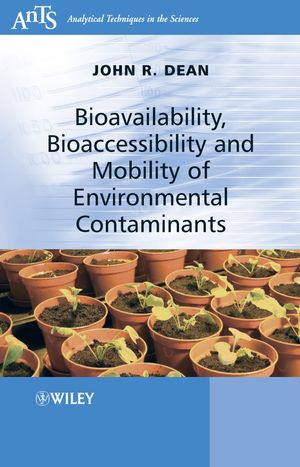Bioavailability, Bioaccessibility and Mobility of Environmental ContaminantsISBN: 978-0-470-02577-2
Hardcover
316 pages
April 2007
 Other Available Formats: Paperback
|
||||||
Series Preface.
Glossary of Terms.
1.0 Contaminated land and the link to human health.
1.1 Introduction.
1.2 Soil Guideline Values.
1.3 Risk to humans.
1.4 An approach to assess contaminated soils relative to soil guidelines values.
1.4.1 Mean value test.
1.4.2 Maximum value test.
1.5 Summary.
1.6 References.
2.0 Sample preparation and analytical techniques for elemental analysis of environmental contaminants.
2.1 Introduction.
2.2 Sample preparation for elemental analysis.
2.2.1 Solid samples.
2.2.2 Liquid samples.
2.3 Atomic absorption spectroscopy.
2.4 Atomic Emission Spectroscopy.
2.5 Inorganic Mass Spectrometry.
2.5.1 Interferences in ICP-MS.
2.6 X-ray fluorescence spectroscopy.
2.7 Electrochemistry.
2.8 Hyphenated Techniques.
2.9 Comparison of elemental analytical techniques.
2.10 Selected resources on elemental analytical techniques.
2.10.1 Specific books on atomic spectroscopy.
2.10.2 Specific books on electroanalytical techniques.
2.11 Summary.
3.0 Sample preparation and analytical techniques for persistent organic pollutant analysis of environmental contaminants. 3.1 Introduction.
3.2 Sample preparation for persistent organic pollutant analysis.
3.2.1 Solid samples.
3.2.2 Liquid samples.
3.3 Gas chromatography.
3.4 High performance liquid chromatography.
3.5 Interfacing chromatography and mass spectrometry.
3.6 Comparison of persistent organic pollutant analytical techniques.
3.7 Selected resources on persistent organic pollutant techniques.
3.7.1 Specific books on chromatography.
3.8 Summary.
4.0 Methods used to assess bioavailability of metals.
4.1 Non-exhaustive extraction techniques for metals.
4.2 Single extraction methods for metals.
4.3 Sequential extraction techniques for metals.
4.4 Earthworms.
4.4.1Earthworms in bioavailability studies.
4.4.2 Chemical – extraction methods to estimate bioavailability of metals by earthworms.
4.5 Plant uptake.
4.6 Certified Reference Materials.
4.7 Summary.
4.8 References.
5.0 Methods used to assess bioavailability of persistent organic pollutants.
5.1 Introduction.
5.2 Non-exhaustive extraction techniques for POPs.
5.2.1 Selective or mild-solvent extraction.
5.2.2 Cyclodextrin extraction.
5.2.3 Supercritical fluid extraction.
5.2.4 Other approaches.
5.3 Earthworm studies.
5.3.1 Chemical – extraction methods to estimate bioavailability of POPs by earthworms..
5.4 Plant uptake.
5.5 Summary.
5.6 References.
6.0 Methods used to assess bioaccessibility.
6.1 Introduction.
6.2 Introduction to human physiology.
6.3 Considerations in the design and development of a simulated in vitro gastrointestinal extraction method..
6.4 Approaches to assess bioaccessibility of metals.
6.5 Approaches to assess bioaccessibility of persistent organic pollutants.
6.6 Validity for measuring bioaccessibility.
6.7 Summary.
6.8 References.
7.0 Selected case studies on bioavailability, bioaccessibility and mobility of environmental contaminants.
7.1 Bioavailability of metals by plants.
7.1.1 Background.
7.1.2 Experimental.
7.1.3 Results and Discussion.
7.1.4 Conclusion.
7.1.5 References.
7.2 Bioaccessibility of metals from plants.
7.2.1 Background.
7.2.2 Experimental.
7.2.3 Results and Discussion.
7.2.4 Conclusion.
7.3 Bioavailability of POPs by plants.
7.3.1 Background.
7.3.2 Experimental.
7.3.3 Results and Discussion.
7.3.4 Conclusion.
7.4 Bioaccessibility of POPs from plants.
7.4.1 Background.
7.4.2 Experimental.
7.4.3 Results and Discussion.
7.4.4 Conclusion.
8.0 Recording of information in the laboratory and other selected resources..
8.1 Safety.
8.2 Recording of information.
8.3 Selected other resources.



